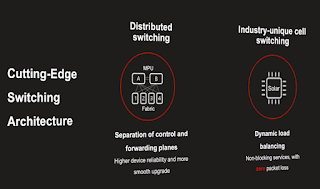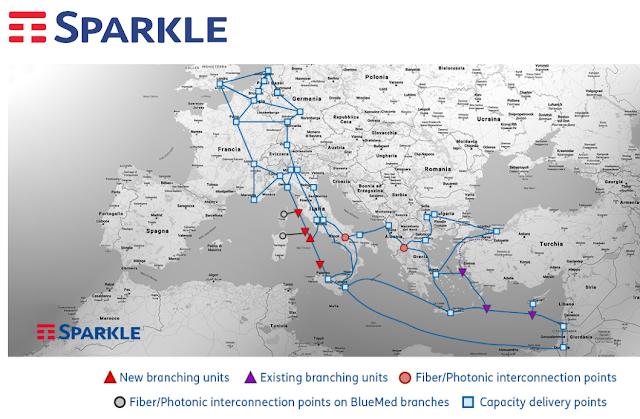Google unveiled plans for new private subsea cable connecting Lisbon, Portugal and Cape Town, South Africa with branching units along the west coast of Africa.
The Equiano subsea cable, which is named for Olaudah Equiano, a Nigerian-born writer and abolitionist who was enslaved as a boy, will include a branching unit to Nigeria.
Google plans to use state-of-the-art space-division multiplexing (SDM) technology to achieve approximately 20 times more network capacity than the last cable built to serve this region.
The cable will be the first to incorporate optical switching at the fiber-pair level, rather than the traditional approach of wavelength-level switching. Google says this design will greatly simplify the allocation of cable capacity.
Equiano is fully funded by Google. Alcatel Submarine Networks was awarded a contract in Q4 2018. The first phase of the project, connecting South Africa with Portugal, is expected to be completed in 2021.
https://cloud.google.com/blog/products/infrastructure/introducing-equiano-a-subsea-cable-from-portugal-to-south-africa
The Equiano subsea cable, which is named for Olaudah Equiano, a Nigerian-born writer and abolitionist who was enslaved as a boy, will include a branching unit to Nigeria.
Google plans to use state-of-the-art space-division multiplexing (SDM) technology to achieve approximately 20 times more network capacity than the last cable built to serve this region.
The cable will be the first to incorporate optical switching at the fiber-pair level, rather than the traditional approach of wavelength-level switching. Google says this design will greatly simplify the allocation of cable capacity.
Equiano is fully funded by Google. Alcatel Submarine Networks was awarded a contract in Q4 2018. The first phase of the project, connecting South Africa with Portugal, is expected to be completed in 2021.
https://cloud.google.com/blog/products/infrastructure/introducing-equiano-a-subsea-cable-from-portugal-to-south-africa
Google to build private "Dunant" cable from Virginia to France
Google is planning a new transatlantic subsea cable system linking the east coast of the United States to Europe to bolster its global network.
Dunant, which is named in honor of Swiss businessman and humanitarian Henri Dunant, will be a four-fiber pair cable system spanning over 6,400km from Virginia Beach to the French Atlantic coast.
 Google has selected TE SubCom to build the Dunant submarine cable system. Activation is expected in late 2020.
Google has selected TE SubCom to build the Dunant submarine cable system. Activation is expected in late 2020.
Google said it continues to consider three options when considering its subsea connectivity needs: (1) purchasing capacity on existing cables (2) joining a consortium to build new cables (3) building a private cable system. In this case, there is a growing need for capacity between its cloud data center regions in Virginia and Belgium.
“We are proud to be working with Google on this important cable system and to be helping to increase internet performance for all,” said Sanjay Chowbey, president of TE SubCom. “The Dunant cable system will be built using SubCom’s industry-leading A1 cable family, which is optimized for projects compatible with higher DCR. As a leading supplier of submarine cable systems, we look forward to continuing to work with our global partners to create more accessible and faster internet access.”
Henri Dunant was the founder of the Red Cross and recipient of the first Nobel Peace Prize.
https://blog.google/products/google-cloud/delivering-increased-connectivity-with-our-first-private-trans-atlantic-subsea-cable/
http://www.te.com/global-en/about-te/news-center/subcom-dunant-cable-system-google-071618.html
Dunant, which is named in honor of Swiss businessman and humanitarian Henri Dunant, will be a four-fiber pair cable system spanning over 6,400km from Virginia Beach to the French Atlantic coast.
 Google has selected TE SubCom to build the Dunant submarine cable system. Activation is expected in late 2020.
Google has selected TE SubCom to build the Dunant submarine cable system. Activation is expected in late 2020.Google said it continues to consider three options when considering its subsea connectivity needs: (1) purchasing capacity on existing cables (2) joining a consortium to build new cables (3) building a private cable system. In this case, there is a growing need for capacity between its cloud data center regions in Virginia and Belgium.
“We are proud to be working with Google on this important cable system and to be helping to increase internet performance for all,” said Sanjay Chowbey, president of TE SubCom. “The Dunant cable system will be built using SubCom’s industry-leading A1 cable family, which is optimized for projects compatible with higher DCR. As a leading supplier of submarine cable systems, we look forward to continuing to work with our global partners to create more accessible and faster internet access.”
Henri Dunant was the founder of the Red Cross and recipient of the first Nobel Peace Prize.
https://blog.google/products/google-cloud/delivering-increased-connectivity-with-our-first-private-trans-atlantic-subsea-cable/
http://www.te.com/global-en/about-te/news-center/subcom-dunant-cable-system-google-071618.html
Google commissions own subsea cable from CA to Chile
TE Subcom has been awarded a contract by Alphabet, the parent company of Google, to build a subsea cable from California to Chile. A ready-for-service date is expected in 2019.
The Curie Submarine Cable will be a four fiber-pair subsea system spanning over 10,000 km from Los Angeles to Valparaiso. It will include a branching unit for future connectivity to Panama.
The project is believed to be the first subsea cable to land in Chile in 20 years.
The Curie Submarine Cable will be a four fiber-pair subsea system spanning over 10,000 km from Los Angeles to Valparaiso. It will include a branching unit for future connectivity to Panama.
The project is believed to be the first subsea cable to land in Chile in 20 years.
Google joins Havfrue and HK-G subsea cable projects
Google announced its participation in the HAVFRUE subsea cable project across the north Atlantic and in the Hong Kong to Guam cable system, both of which are expected to enter service in 2019.
In addition, Google confirmed that it is on-track to open cloud regions (data centers) in the Netherlands and Montreal this calendar quarter, followed by Los Angeles, Finland and Hong Kong.
HAVFRUE is the newly-announced new subsea cable project that will link New Jersey to the Jutland Peninsula of Denmark with a branch landing in County Mayo, Ireland. Optional branch extensions to Northern and Southern Norway are also included in the design. The HAVFRU system will be owned and operated by multiple parties, including Aqua Comms, Bulk Infrastructure, Facebook, Google and others. Aqua Comms, the Irish cable owner/operator and carriers’ carrier, will serve as the system operator and landing party in U.S.A., Ireland, and Denmark. Bulk Infrastructure of Norway will be the owner and landing party for the Norwegian branch options. The HAFVRUE subsea cable system will be optimized for coherent transmission and will offer a cross-sectional cable capacity of 108Tbps, scalable to higher capacities utilizing future generation SLTE technology. SubCom will incorporate their Wavelength Selective Switching Reconfigurable Optical Add Drop Multiplexer (WSS-ROADM) for flexible wavelength allocation over the system design life. It is the first new cable system in almost two decades that will traverse the North Atlantic to connect mainland Northern Europe to the U.S.A. TE Subcom is the system supplier.
The 3,900 kilometer Hong Kong - Guam Cable system (HK-G) will offer 48 Tbps of design capacity when it comes into service in late 2019. It features 100G optical transmission capabilities and is being built by RTI Connectivity Pte. Ltd. (RTI-C) and NEC Corporation with capital from the Fund Corporation for the Overseas Development of Japan's ICT and Postal Services Inc. (Japan ICT Fund), along with syndicated loans from Japanese institutions including NEC Capital Solutions Limited, among others. In Hong Kong, the cable is slated to land in Tseung Kwan O (TKO) and will land in Piti, Guam at the recently completed Teleguam Holdings LLC (GTA) cable landing station. HK-G will land in the same facility as the Southeast Asia - United States Cable System (SEA-US).
Google also noted its direct investment in 11 cables, including those planned or under construction:
In addition, Google confirmed that it is on-track to open cloud regions (data centers) in the Netherlands and Montreal this calendar quarter, followed by Los Angeles, Finland and Hong Kong.
HAVFRUE is the newly-announced new subsea cable project that will link New Jersey to the Jutland Peninsula of Denmark with a branch landing in County Mayo, Ireland. Optional branch extensions to Northern and Southern Norway are also included in the design. The HAVFRU system will be owned and operated by multiple parties, including Aqua Comms, Bulk Infrastructure, Facebook, Google and others. Aqua Comms, the Irish cable owner/operator and carriers’ carrier, will serve as the system operator and landing party in U.S.A., Ireland, and Denmark. Bulk Infrastructure of Norway will be the owner and landing party for the Norwegian branch options. The HAFVRUE subsea cable system will be optimized for coherent transmission and will offer a cross-sectional cable capacity of 108Tbps, scalable to higher capacities utilizing future generation SLTE technology. SubCom will incorporate their Wavelength Selective Switching Reconfigurable Optical Add Drop Multiplexer (WSS-ROADM) for flexible wavelength allocation over the system design life. It is the first new cable system in almost two decades that will traverse the North Atlantic to connect mainland Northern Europe to the U.S.A. TE Subcom is the system supplier.
The 3,900 kilometer Hong Kong - Guam Cable system (HK-G) will offer 48 Tbps of design capacity when it comes into service in late 2019. It features 100G optical transmission capabilities and is being built by RTI Connectivity Pte. Ltd. (RTI-C) and NEC Corporation with capital from the Fund Corporation for the Overseas Development of Japan's ICT and Postal Services Inc. (Japan ICT Fund), along with syndicated loans from Japanese institutions including NEC Capital Solutions Limited, among others. In Hong Kong, the cable is slated to land in Tseung Kwan O (TKO) and will land in Piti, Guam at the recently completed Teleguam Holdings LLC (GTA) cable landing station. HK-G will land in the same facility as the Southeast Asia - United States Cable System (SEA-US).
Google also noted its direct investment in 11 cables, including those planned or under construction:















































